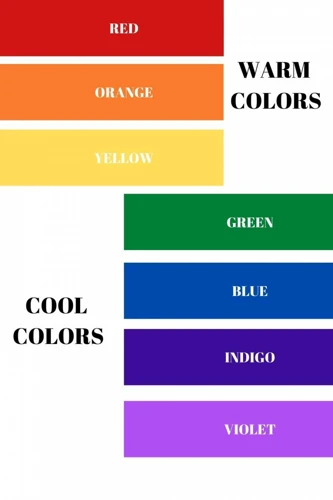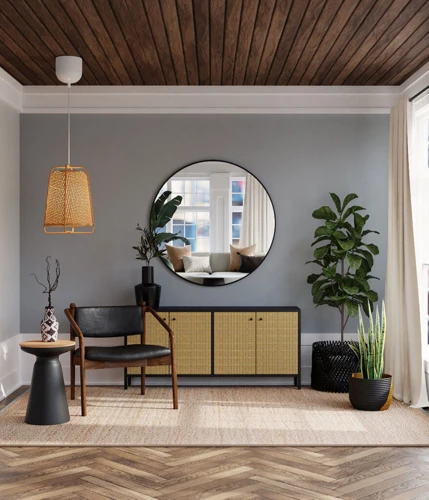The essence of warm and cool colors in interior design is rooted in how they influence the atmosphere of a space. Colors are not just visual elements; they have the power to evoke emotions, alter perceptions, and even influence physical comfort.
Exploring Color Theory in Room Design
Delving into color theory in room design is fundamental for crafting aesthetically pleasing spaces. The color wheel is divided into warm and cool hues, each offering distinct vibes and visual effects. Understanding these principles is key to selecting the perfect palette for your interiors.
The Impact of Color Temperature in Home Decor
The concept of color temperature in home decor plays a pivotal role in setting the mood of a room. Warm shades often convey coziness and energy, while cool tones are associated with tranquility and sophistication. This psychological impact is an important consideration in design decisions.
Incorporating Warm Colors in Decor
Introducing incorporating warm colors in decor can transform a room into a welcoming and vibrant space. These hues, reminiscent of sunlight and fire, can make large, impersonal areas feel more intimate and inviting.
Choosing a Warm Color Palette for Comfort
When choosing a warm color palette for comfort, consider shades like reds, oranges, and yellows. These colors can stimulate conversation and create a sense of warmth, ideal for living rooms and dining areas where social interactions are key.
Mixing Warm Colors with Neutrals for Balance
While warm shades can energize a space, it is crucial to mix warm colors with neutrals to maintain balance. This approach prevents the room from becoming overwhelming and allows for a more sophisticated and grounded aesthetic.
Selecting Cool Colors for Home
In contrast, choosing cool colors for home can cultivate a serene and professional atmosphere. These hues reflect the colors of water, sky, and foliage, promoting a sense of calm and focus.
The Psychology of Cool Hues in Living Spaces
The psychology of cool hues in living spaces suggests that these colors can have a soothing effect, making them ideal for bedrooms and bathrooms where relaxation is paramount.
Creating a Serene Atmosphere with Cool Colors
To achieve a tranquil vibe, creating a serene atmosphere with cool colors involves selecting shades like blues, greens, and purples. These tones can also make small rooms appear more spacious and airy.
Balancing Warm and Cool Hues in a Room
Balancing warm and cool hues in a room is essential for achieving a harmonious look. The interplay of these colors can enhance the visual dynamics and create a more nuanced and inviting space.
Combining Warm and Cool Colors for Harmony
Combining warm and cool colors for harmony requires a thoughtful approach. It’s about finding the right proportion and placement to ensure that neither temperature overpowers the other.
The 60-30-10 Rule in Color Balancing
A popular guideline for color distribution is the 60-30-10 rule in color balancing. This principle suggests using 60% of a dominant color, 30% of a secondary color, and 10% of an accent color to create a cohesive palette.
Warm vs Cool Color Palette
In interior design, the debate between a warm vs cool color palette often arises. Each palette can set a very different tone and mood in a space, and understanding their effects can assist in making informed decisions.
Identifying the Dominant Palette in Your Space
Identifying the dominant palette in your space is a starting point for designing a room. Assessing the room’s orientation, natural light, and existing furnishings can guide you towards a palette that enhances its best features.
Adjusting Your Palette for Seasonal Changes
Seasons affect our mood and the ambiance we wish to create at home. Thus, adjusting your palette for seasonal changes can rejuvenate your living space and align with the time of the year.
Mixing Warm and Cool Colors
The art of mixing warm and cool colors is an advanced technique in interior design that, when done correctly, can result in a dynamic and visually interesting space.
Strategies for Blending Opposite Temperatures
Effective strategies for blending opposite temperatures include using transitional colors that can bridge the gap between warm and cool, or incorporating elements that feature both temperatures in their design.
Creating Focal Points with Contrasting Colors
One method is creating focal points with contrasting colors. A cool-colored wall with a warm-hued painting can draw the eye and serve as a central feature in a room.
Creating Harmony with Warm and Cool Colors
Creating harmony with warm and cool colors is about more than just balance; it’s about achieving a seamless flow of energy and aesthetics throughout a space.
Using Textiles to Unify Diverse Color Schemes
Textiles are a versatile tool in unifying diverse color schemes. Rugs, curtains, and cushions can weave together warm and cool tones for a cohesive look.
Accessorizing with Art and Decor to Tie Colors Together
Moreover, accessorizing with art and decor can play a pivotal role. These elements can bridge disparate color applications, ensuring a harmonious blend throughout the room.
Warm Cool Color Scheme Ideas
Seeking warm cool color scheme ideas is a delightful process that can inspire unique and personalized interior designs. The juxtaposition of warm and cool tones can cater to a variety of aesthetic preferences and functions.
Inspiring Combinations for Different Room Types
Inspiring combinations may vary from fiery oranges against cool blues for an energetic vibe to soft pinks paired with mint greens for a delicate balance.
Case Studies: Successful Warm and Cool Interiors
Examining case studies of successful warm and cool interiors can offer tangible insights and inspiration. These real-life examples highlight the practical application of color theory in creating captivating spaces.
Practical Tips for Your Home
Applying color theory in your home can be both rewarding and challenging. Here are some practical tips to ensure your success.
How to Test Color Palettes Before Committing
One approach is how to test color palettes before committing. Samples and swatches can be invaluable resources, allowing you to envision the colors in different lighting and alongside your furniture.
When it comes to home decor, the colors you choose for your space can dramatically affect the ambiance and mood of your room. If you’re interested in creating a serene and calming atmosphere, exploring the use of calming cool colors in interior design can provide you with the inspiration you need. On the other hand, if you’re looking to foster a cozy and inviting environment, then you might enjoy reading about warm colors for your living room. And for a broader understanding of how cool colors can enhance the overall ambiance of your home, don’t miss our insights on cool colors and home ambiance. Whether you’re looking to incorporate warm or cool tones, these articles will guide you in creating a harmonious balance that suits your personal style and room’s function.
Maintaining Flexibility in Your Color Choices
Lastly, maintaining flexibility in your color choices is crucial. As your style evolves or new trends emerge, having a versatile color scheme will make it easier to update your decor without a complete overhaul.
With these insights and tips, you’re well on your way to mastering the use of warm and cool colors in your home. Whether you’re aiming for a cozy, vibrant atmosphere or a tranquil, sophisticated space, the right balance of hues can make all the difference in your interior design journey.




